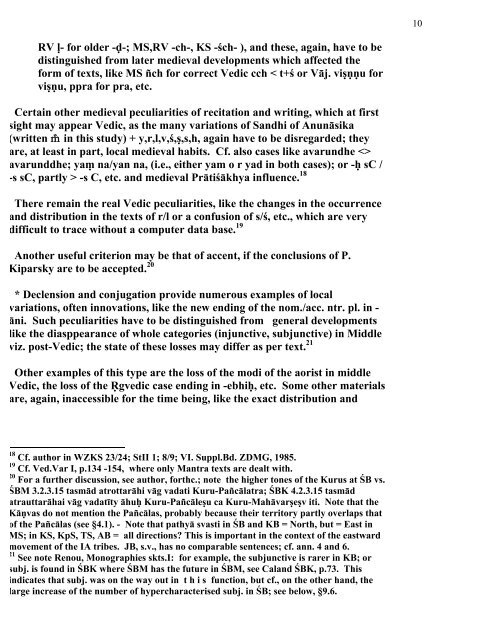TRACING VEDIC DIALECTS - People.fas.harvard.edu
TRACING VEDIC DIALECTS - People.fas.harvard.edu
TRACING VEDIC DIALECTS - People.fas.harvard.edu
You also want an ePaper? Increase the reach of your titles
YUMPU automatically turns print PDFs into web optimized ePapers that Google loves.
RV ḷ- for older -ḍ-; MS,RV -ch-, KS -śch- ), and these, again, have to be<br />
distinguished from later medieval developments which affected the<br />
form of texts, like MS ñch for correct Vedic cch < t+ś or Vāj. viṣṇṇu for<br />
viṣṇu, ppra for pra, etc.<br />
Certain other medieval peculiarities of recitation and writing, which at first<br />
sight may appear Vedic, as the many variations of Sandhi of Anunāsika<br />
(written in this study) + y,r,l,v,ś,ṣ,s,h, again have to be disregarded; they<br />
are, at least in part, local medieval habits. Cf. also cases like avarundhe <br />
avarunddhe; yaṃ na/yan na, (i.e., either yam o r yad in both cases); or -ḥ sC /<br />
-s sC, partly > -s C, etc. and medieval Prātiśākhya influence. 18<br />
There remain the real Vedic peculiarities, like the changes in the occurrence<br />
and distribution in the texts of r/l or a confusion of s/ś, etc., which are very<br />
difficult to trace without a computer data base. 19<br />
Another useful criterion may be that of accent, if the conclusions of P.<br />
Kiparsky are to be accepted. 20<br />
* Declension and conjugation provide numerous examples of local<br />
variations, often innovations, like the new ending of the nom./acc. ntr. pl. in -<br />
āni. Such peculiarities have to be distinguished from general developments<br />
like the diasppearance of whole categories (injunctive, subjunctive) in Middle<br />
viz. post-Vedic; the state of these losses may differ as per text. 21<br />
Other examples of this type are the loss of the modi of the aorist in middle<br />
Vedic, the loss of the Ṛgvedic case ending in -ebhiḥ, etc. Some other materials<br />
are, again, inaccessible for the time being, like the exact distribution and<br />
18 Cf. author in WZKS 23/24; StII 1; 8/9; VI. Suppl.Bd. ZDMG, 1985.<br />
19 Cf. Ved.Var I, p.134 -154, where only Mantra texts are dealt with.<br />
20 For a further discussion, see author, forthc.; note the higher tones of the Kurus at ŚB vs.<br />
ŚBM 3.2.3.15 tasmād atrottarāhi vāg vadati Kuru-Pañcālatra; ŚBK 4.2.3.15 tasmād<br />
atrauttarāhai vāg vadatīty āhuḥ Kuru-Pañcāleṣu ca Kuru-Mahāvarṣeṣv iti. Note that the<br />
Kāṇvas do not mention the Pañcālas, probably because their territory partly overlaps that<br />
of the Pañcālas (see §4.1). - Note that pathyā svasti in ŚB and KB = North, but = East in<br />
MS; in KS, KpS, TS, AB = all directions? This is important in the context of the eastward<br />
movement of the IA tribes. JB, s.v., has no comparable sentences; cf. ann. 4 and 6.<br />
21 See note Renou, Monographies skts.I: for example, the subjunctive is rarer in KB; or<br />
subj. is found in ŚBK where ŚBM has the future in ŚBM, see Caland ŚBK, p.73. This<br />
indicates that subj. was on the way out in t h i s function, but cf., on the other hand, the<br />
large increase of the number of hypercharacterised subj. in ŚB; see below, §9.6.<br />
10
















